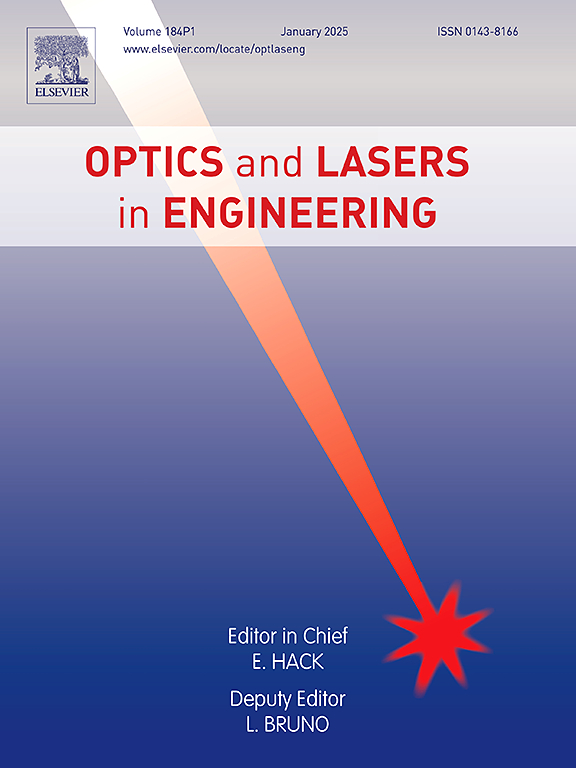Compact, highly sensitive, rapid continuous measurement of carbon dioxide released from fruits and vegetables based on QEPAS and TDLAS dual spectrum multiplexing technology
IF 3.5
2区 工程技术
Q2 OPTICS
引用次数: 0
Abstract
This paper presents the development of a compact, highly sensitive and rapid continuous measurement CO2 sensor based on the multiplexing of quartz-enhanced photoacoustic spectroscopy (QEPAS) and tunable diode laser absorption spectroscopy (TDLAS). The sensor utilizes a distributed feedback (DFB) laser diode with wavelength of 2004 nm as the excitation source, while the photoacoustic signal is generated using a commercially available, low-cost 30.720 kHz quartz tuning fork (QTF). The fiber-coupled grin collimator, QTF, acoustic micro-resonator, CO2 reference cell, photodiode, gas chamber, thermistor, and Peltier were all integrated to create an ultra-compact acoustic detection module (ADM) with dimensions of 44.50 × 26.00 × 17.50 mm. In dual spectrum multiplexing technique, the detection limit of CO2 was 8.7 ppm at 1 s, corresponding to a normalized noise equivalent absorption coefficient of 6.20 × 10–9 W·cm-1·Hz-1/2. The long-term performance and stability of the QEPAS CO2 sensor were evaluated through Allan deviation. Eventually, the minimum detection limit (MDL) increased to 0.7 ppm at 228 s. The QEPAS CO2 sensor was developed for fast and highly sensitive measurements of CO2 respiration rate in different fruit species. Among the six kinds of fruit and vegetable, edamame exhibited the highest CO2 respiration rate, with an average of 55.16 ± 0.67 mL kg⁻¹ h⁻¹, while red grapes showed the lowest rate, averaging 6.12 ± 0.09 mL kg⁻¹ h⁻¹.
基于QEPAS和TDLAS双频谱复用技术的紧凑,高灵敏度,快速连续测量水果和蔬菜中释放的二氧化碳
本文介绍了一种基于石英增强光声光谱(QEPAS)和可调谐二极管激光吸收光谱(TDLAS)复用技术的紧凑、高灵敏度和快速连续测量CO2传感器的研制。该传感器采用波长为2004 nm的分布式反馈(DFB)激光二极管作为激励源,而光声信号则使用市售的低成本30.720 kHz石英音叉(QTF)产生。将光纤耦合grin准直器、QTF、声学微谐振器、CO2参考池、光电二极管、气室、热敏电阻和Peltier集成在一起,形成了一个超紧凑的声学检测模块(ADM),尺寸为44.50 × 26.00 × 17.50 mm。在双光谱复用技术中,CO2在1 s的检出限为8.7 ppm,对应于归一化噪声等效吸收系数为6.20 × 10-9 W·cm-1·Hz-1/2。通过Allan偏差对QEPAS CO2传感器的长期性能和稳定性进行了评价。最终,最小检出限(MDL)在228 s时增加到0.7 ppm。QEPAS二氧化碳传感器用于快速、高灵敏度地测量不同水果的二氧化碳呼吸速率。在6种果蔬中,毛豆的二氧化碳呼吸速率最高,平均为55.16±0.67 mL kg⁻¹;红葡萄的二氧化碳呼吸速率最低,平均为6.12±0.09 mL kg⁻¹。
本文章由计算机程序翻译,如有差异,请以英文原文为准。
求助全文
约1分钟内获得全文
求助全文
来源期刊

Optics and Lasers in Engineering
工程技术-光学
CiteScore
8.90
自引率
8.70%
发文量
384
审稿时长
42 days
期刊介绍:
Optics and Lasers in Engineering aims at providing an international forum for the interchange of information on the development of optical techniques and laser technology in engineering. Emphasis is placed on contributions targeted at the practical use of methods and devices, the development and enhancement of solutions and new theoretical concepts for experimental methods.
Optics and Lasers in Engineering reflects the main areas in which optical methods are being used and developed for an engineering environment. Manuscripts should offer clear evidence of novelty and significance. Papers focusing on parameter optimization or computational issues are not suitable. Similarly, papers focussed on an application rather than the optical method fall outside the journal''s scope. The scope of the journal is defined to include the following:
-Optical Metrology-
Optical Methods for 3D visualization and virtual engineering-
Optical Techniques for Microsystems-
Imaging, Microscopy and Adaptive Optics-
Computational Imaging-
Laser methods in manufacturing-
Integrated optical and photonic sensors-
Optics and Photonics in Life Science-
Hyperspectral and spectroscopic methods-
Infrared and Terahertz techniques
 求助内容:
求助内容: 应助结果提醒方式:
应助结果提醒方式:


